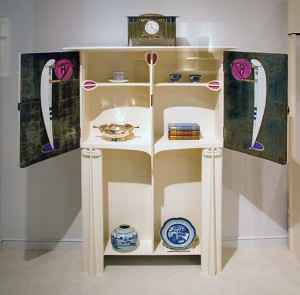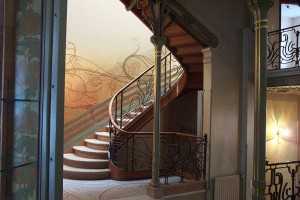
Born on January 6, 1861 in Ghent, Belgium, Victor Horta was an early Art Nouveau architect. 1 Horta is often regarded as one of the early forerunners of the Art Nouveau movement in modern architecture. At the age of 12, Horta began his formal architectural studies at the Académie des Beaux-Arts in 1873. Shortly after, Horta transitioned to the Athénée Royal in 1874 and continued to study there for next 3 years. 2 Horta later left his hometown of Ghent, Belgium to study in Brussels at the Académie Royale des Beaux-Arts where he examined Neoclassicism under the instruction of Alphonse Balat. In the subsequent years Horta participated and won many design competitions, including winning the Godecharle prize for his design of a new parliament building.
Horta was no doubt an early pioneer in the Art Nouveau movement. Art Nouveau, or “New Art”, was a style that was developed in the 1880’s in parts of Europe and the United States. This style emphasized curvilinear lines, organic shapes, botanical influences, and “whiplash” curves. 3 Art Nouveau permeated all types of art forms from architecture, to graphic design, to painting. Many artists sought Art Nouveau as a way to break free from old styles and achieve more artistic freedom. The sinuous and fluid lines seen in Art Nouveau are quite literal representations of artists and their attempts to break free from the rigidity of past forms. As seen in the Cabinet by Charles Rennie Mackintosh (Figure 1), the detailing is very reminiscent of organic floral forms in influences.
Horta, like many other Art Nouveau artists, frequently utilized plant-like forms in his architectural designs. Some of his most representative designs include that of Hotel Tassel and Hotel Solvay. Both of these works are characterized by intricate wrought iron work on the exteriors and interiors, the adherence to an open plan, and the emphasis on organic and natural forms; all representative features of Horta’s work. 4 These themes were especially revolutionary for the development of modern architecture because Horta was one of the few architects of his time to be using iron in a domestic setting.

Hotel Tassel was a townhouse located in Brussels, Belgium that Horta designed in 1893. 5 A closer examination of the interior of Hotel Tassel shows many Art Nouveau influences. As seen in Figure 2, the railing of the staircase shows many curvilinear forms made of wrought iron. In addition, the illustrations on the wall also show the “whiplash” forms often associated with Art Nouveau artists and Horta himself. And finally, the use of innovative materials and techniques as seen on Horta’s use of electricity in Hotel Tassel were also very forward thinking of his time. Electricity and wrought iron are just two instances of Horta’s widespread use of industrial materials in domestic applications.
Over the course of his lifetime, Horta accomplished many things outside of architectural design. In addition to being an architect, Horta was also an educator and professor and a writer. In the fall of 1947, Victor Horta passed away on September 8th after a life of prolific work. 6 To this day, many still look back upon Horta’s work and recall the forward-thinking nature of his designs with regards to the Art Nouveau movement and the technological advancement of his time.
– JX
Figure 1: Cabinet (1902) Charles Rennie Mackintosh. Photographer: Tony Hisgett, Wikimedia Commons. Link. (Accessed November 4, 2015)
Figure 2: Hotel Tassel (1893) Brussels, Belgium. Victor Horta. Photographer: Henry Townsend, WIkimedia Commons. Link. (Accessed November 4, 2015)
Notes:
- “Biography.” Horta Museum. Accessed October 30, 2015. ↩
- “Victor, Baron Horta. Biography – Belgian Architect.” Encyclopedia Britannica Online. Accessed November 1, 2015. ↩
- “Art Nouveau.” The Metropolitan Museum of Art. Accessed November 1, 2015. ↩
- “Major Town Houses of the Architect Victor Horta (Brussels).” UNESCO World Heritage Centre. Accessed November 1, 2015. ↩
- Ibid. ↩
- Ibid. ↩
